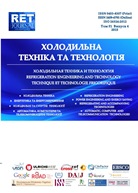ЕКСПЕРИМЕНТАЛЬНЕ І РОЗРАХУНКОВЕ ДОСЛІДЖЕННЯ ВПЛИВУ НАНОЧАСТОК Al2O3 НА ТЕПЛОФІЗИЧНІ ВЛАСТИВОСТІ РОЗЧИНІВ ХОЛОДОАГЕНТУ R600а З КОМПРЕСОРНИМ МАСТИЛОМ
DOI:
https://doi.org/10.15673/0453-8307.4/2015.44780Schlagworte:
Нанофлюїди, Розчини холодоагент/мастило, В'язкість, Тиск насичених парів, Поверхневий натяг, Експеримент, Методи розрахункуAbstract
У статті наведено результати експериментального та розрахункового дослідження впливу домішок наночасток Al2O3 на значення в'язкості, тиску насичених парів, поверхневого натягу розчинів холодоагенту R600a/мінеральне мастило. Вперше для опису отриманих експериментальних даних та прогнозування теплофізичних властивостей нанофлюїдів в широкому інтервалі параметрів стану була застосована модель SP-QSPR - Skaling Principles - Quantitative Structure-Property Relationship. Показано, що домішки наночасток в розчинах холодоагент/мастило сприяють збільшенню в'язкості і тиску насичених парів, зменшенню поверхневого натягу. Зазначені ефекти повинні враховуватися при оцінці перспективності застосування нанотехнологій в холодильному обладнанні.Literaturhinweise
Xiang-Qi Wang, Arun S. Mujumdar 2008. A Review on Nanofluids – Part I: Theoretical and Nu-merical Investigations Brazilian Journal of Chemical Engineering. Vol. 25, No. 04, 613-630. doi: 10.1590/S0104-66322008000400001
NIST Thermodynamic properties of refrigerants and refrigerants mixtures database (REFPROP) Version 7.1 M. O. McLinden, S. A. Klein, E. W. Lemmon, A. P. G. Peskin – Gaithersburg: National Institute of Standard and Technology. – 2003
Zhelezny, V., Sechenyh, V., Nikulina, A. A New Scaling Principles–Quantitative Structure Property Relationship Model (SP-QSPR) for Predicting the Physicochemical Properties of Substances at the Satu-ration Line. Journal of Chemical & Engineering Data, №59 (2), 485–493. doi:10.1021/je400933x
Zhelezny, V.P., Semenyuk, Yu.V., Lozovskyy, T.L., Markvart, A.S. 2012. Prediction methods of pseudocritical parameters for refrigerant/oil solutions. Vestnyk MAKH [Vestnik of International Academy of Refrigeration], №1, 48-52. (in Russian)
Hryhor'ev, B.A. 1999. Thermophysical properties of oil, petroleum, gas condensates and their fractions / B.A. Hryhor'ev, H.F. Bohatov, A.A. Herasymov. - M: Yzdatel'stvo MЭY. – 372 p. (in Russian)
Zhelezny, V.P. Cheremnykh, Y.V., Bisko, E.G. 1999. New vapor pressure equation for non-associated substances. High Temperatures – High Pressures. Vol.31, № 2, 163-168. doi:10.1068/htec252
Skripov, P. V. Starostin, A. A., Volosnikov, D. V., Zhelezny, V. P. 2003. Comparison of thermophysical properties for oil/ refrigerant mixtures by use of pulse heating method International Journal of Refrig-eration. Vol.26, Iss. 3., 721-728. doi:10.1016/S0140-7007(02)00163-9
Lozovskyy, T. L., Semenyuk, Yu. V., Ivchenko, D. A., Prykhodchenko, N.A., Zhelezny, V.P. 2009. Surface tension of refrigerant mixtures and refrigerant/oil solutions. Experiment, prediction methods. Part 3: Surface tension of refrigerant/oil solutions. Kholodyl'naya tekhnyka i tekhnologia [Refrigeration Engineering and Technology]. № 6 (122), 38-46. (in Russian)
Zhelezny, P.V. Zhelezny, V.P., Procenko, D.A., Ancherbak, S.N. 2007. An Experimental Investigation and Modelling of the Thermodynamic Properties of Isobutane - Compressor Oil Solutions. Some Aspects of Experimental Methodology. International Journal of Rerigeration. Vol.30., Iss.3., 433 – 445. doi:10.1016/j.ijrefrig.2006.09.007
Nikulina A.S. 2014. Prediction of the thermophysical properties for the multicompo-nent solutions with undefined composition: dys. kand. tekhn. nauk. – Odessa.– 163 p. (in Russian)


